The spring housing market, traditionally a vibrant season for real estate, is presenting a dismal picture in 2024. With higher mortgage rates and growing anxiety around economic stability, the sale of previously owned homes plummeted by 5.9% in March, dropping to a seasonally adjusted annual rate of just 4.02 million units. This marks the weakest performance for March sales since 2009—a period characterized by economic strife and uncertainty. To put this into perspective, March sales figures fell 2.4% compared to the same month in the prior year, raising concerns about the vitality of the housing market across the United States.
The most stark declines were seen in the Western region of the country, where home sales plummeted by over 9%. The West has always commanded higher prices and, while it enjoyed some year-on-year gains due to robust job growth in places like the Rocky Mountain states, the overall trend is alarming. This regional disparity highlights the growing divide in economic health across different parts of the nation and calls attention to the pressing need for local policy adjustments that could reinvigorate these markets.
Affordability Crisis and Its Ripple Effects
The primary driver behind the stagnation is sharply rising mortgage rates, which hover over the 7% mark, making homeownership an elusive dream for many. As highlighted by Lawrence Yun, Chief Economist at the National Association of Realtors (NAR), the affordability concerns are palpable. A direct consequence of these high mortgage rates is a historical low in residential housing mobility, which not only exacerbates the current housing crisis but also stifles broader economic mobility. The implication here is profound: stagnant housing markets can lead to less resource allocation and boast a negative feedback loop for job creation, putting a brake on economic progress.
Additionally, despite a 20% increase in available listings with 1.33 million units up for grabs, this influx has not led to a rejuvenation of sales. This contradicts the common belief that more inventory would lead to brisker transactions; instead, it showcases the profound malaise that is affecting potential buyers. With sales moving at a pace that translates to a mere four-month supply of homes—a far cry from the six-month supply typically indicated as balanced—the market is becoming increasingly competitive for buyers yet still yields a cautious approach.
Price Trends and Their Implications
Interestingly, while the median price of homes hit a historic high of $403,700 in March, the gains have significantly softened, with year-over-year appreciation shrinking to just 2.7%. This signals a cooling trend that could threaten many areas of the housing market. On the surface, rising home prices may seem to benefit homeowners, yet this trend masks the reality that fewer prospective buyers can afford to enter the market, further entrenching the existing owners in their long-term residences. Thus, while household wealth tied up in real estate seems robust—with valuations hitting a staggering $52 trillion—a deeper investigation reveals this wealth is increasingly concentrated and reflective of systemic inequality.
First-time buyers making up only 32% of the market—the same proportion as last year—gives us pause for reflection. Historically, this demographic represented around 40% of the total market, a decline which can have damaging repercussions for future market vitality. Emerging from this trend are the monstrous implications for a generation that finds itself locked out of homeownership, leading to lingering doubts regarding future economic stability.
In an unsettling twist, reports of canceled contracts and waning confidence, especially following stock market fluctuations in April, cast a long shadow over the market’s future. Economists like Robert Frick from Navy Federal Credit Union are already bracing for even more disheartening numbers, urging immediate action and practical solutions to address an escalating crisis that isn’t merely a blip but could turn into a structural dilemma.
Defining the Path Forward
If policymakers and market stewards do not intervene promptly to address these critical issues—the soaring mortgage rates, diminishing affordability, and the disparity between regions—what lies ahead may be a further descent into chaos. The housing market isn’t just a barometer of economic health; it’s the linchpin of the American Dream. By recognizing the urgency of these trends, we can advocate for targeted strategies that not only revive the market but ensure it remains accessible for future generations.


Leave a Reply